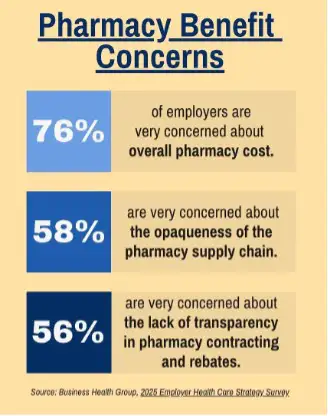Employers across the country are facing rising health plan costs and are being forced to make tough choices – absorb higher expenses themselves or pass the burden onto employees through increased premiums, co-pays, and deductibles.
Results from the 2024 National Survey of Employer-Sponsored Health Plans show that employers expect the total cost of health benefits per employee to rise by an average of 5.8% in 2025 – and that’s with taking steps to control costs. Without any cost-reduction efforts, that increase could climb to around 7%.
To understand why employer-sponsored health plan benefit costs are climbing so rapidly, it’s essential to examine one of the fastest-growing drivers of those expenses: prescription drugs.
The Growing Burden of Prescription Drug Costs
Prescription drug costs have consistently risen three times the rate of inflation, placing a growing strain on employer-sponsored health plans. Specifically, drug prices in 2024 were more than five times higher than in 1985 – a staggering increase driven by various factors.

From the rising use of specialty medications to the lack of transparency in the pharmacy benefits system, these issues and more are making it increasingly difficult for employers to manage healthcare expenses and provide affordable coverage.
According to the Business Health Group’s 2025 Employer Health Care Strategy Report, 76% of employers are very concerned about rising pharmacy costs. More than half also worry about the lack of transparency in the pharmacy supply chain (58%) and in contracting and rebates (56%).
Prescription Drug Spend: The Cost Hiding in Plain Sight
If you haven’t been paying much attention to prescription drug costs in your health plan, you’re not the only one. Many employers don’t realize how much of their healthcare spending comes from the pharmacy benefit.
Here’s why drug costs are often overlooked and why they are becoming a bigger part of the problem:
- Lack of Transparency: Traditional Pharmacy Benefit Managers (PBMs) often bundle pharmacy costs with medical claims, making it hard to isolate the impact of drug spending.
- Complex Rebates and Pricing Models: Employers may think they are saving money through large rebates on brand name drugs, but those drugs can have cheaper alternatives that are just as effective. On top of that, some PBMs keep part of the rebate instead of passing the full savings back to the employer.
- Focus on Premiums, Not Components: Employers often look at total premium increases year over year without digging into what’s driving those increases. Prescription costs are often buried in the fine print.
- Misleading Reports: Some PBMs provide summary reports that withhold important details, such as the true cost of drugs, or they may not provide any data at all. These incomplete or vague reports can make it hard for employers to see the real impact of drug costs on their health plans.
How Employers Can Address Rising Prescription Drug Costs
Employers have several strategies they can use to better manage rising prescription drug costs:
- Demand Full Transparency in PBM Contracts: Ensure that PBM contracts are clear, with no hidden fees or complicated rebate structures that obscure actual savings.
- Evaluate PBM Models that Focus on Net Cost Savings Over Rebates: Employers should look for PBMs that prioritize the organization’s net savings rather than relying on opaque rebate structures that may not deliver tangible cost reductions.
- Work with Fully Transparent Partners: Some providers operate with full transparency, allowing employers to easily see how much they are saving and where those savings come from. Working with them can help employers avoid the complexities of spread pricing and ensure that they’re getting the best deal.
Don’t Wait to Start Saving
The longer employers wait to take control of rising prescription drug costs, the longer it will be before they start saving money and gaining control of their health plan budgets. Taking action now is the first step toward creating a more sustainable and affordable health plan for the future.

